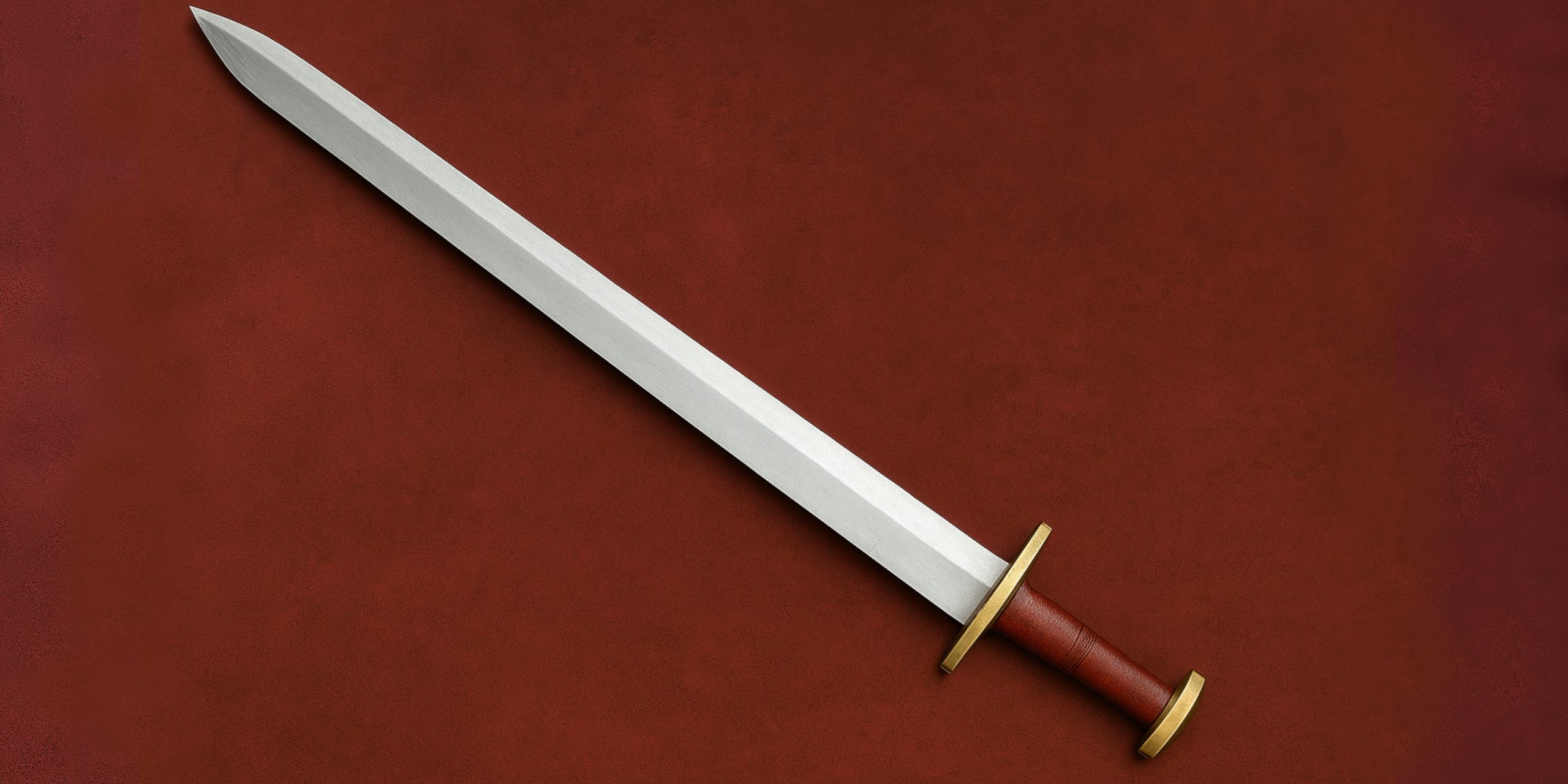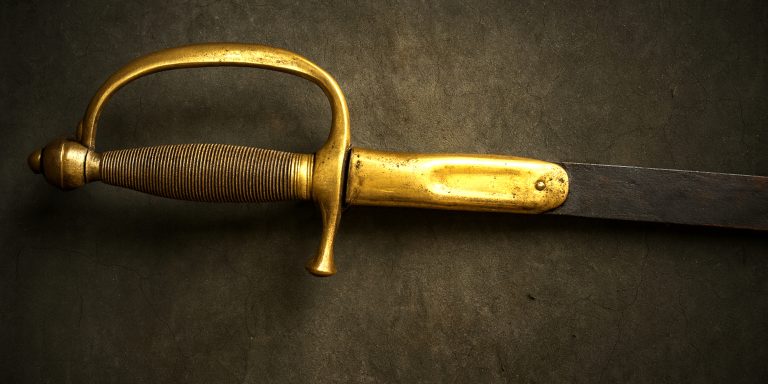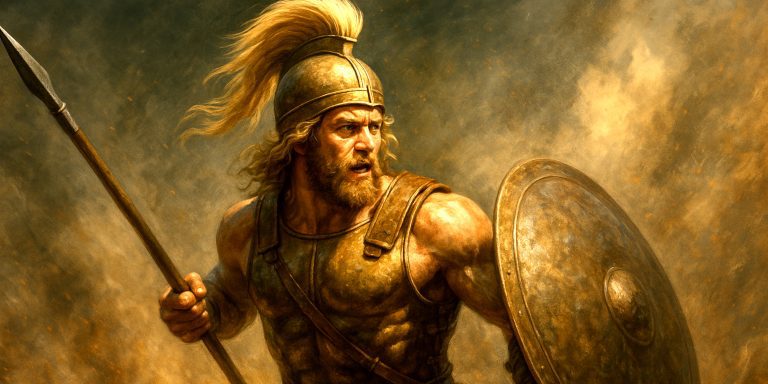
The Visigoths, a branch of the Gothic peoples who helped bring about the fall of the Western Roman Empire, left behind a legacy of warcraft and cultural fusion. Among their most significant martial artefacts is the Visigoth sword, a weapon that reflects both Germanic traditions and late Roman influence.
The Visigoth sword refers to a class of single-handed, straight-bladed swords used by the Visigoths during the 5th to 8th centuries AD. Though few complete examples survive, archaeological finds and contemporary references provide insight into its design and function. It was a status symbol as much as a battlefield weapon, often richly decorated and buried with its owner.
Below: Visigoth Spatha

Specification
| Feature | Details |
|---|---|
| Type | Double-edged spatha-style sword |
| Blade Length | 70–85 cm |
| Total Length | 85–100 cm |
| Blade Shape | Straight, tapering slightly to the point |
| Blade Cross-section | Lenticular or flattened diamond |
| Hilt | Short guard, simple or lobed pommel |
| Material | Pattern-welded iron or steel |
| Scabbard | Often wooden, leather-covered, sometimes with mounts |
| Grip | Organic material (wood, bone or horn), rarely preserved |
History and Evolution
- Early Development: The Visigoth sword evolved from the Roman spatha, a cavalry sword used widely across the late Roman Empire. As Roman authority waned, Germanic tribes adopted and adapted these swords.
- 5th–6th Century: By the time the Visigoths had established themselves in Hispania and Gaul, the sword had taken on more decorative features, including inlaid pommels and ornate guards, reflecting elite status.
- Post-Visigothic Use: After the fall of the Visigothic Kingdom in 711 AD, the sword type influenced early medieval Iberian designs and persisted in modified form among Christian kingdoms during the Reconquista.
Advantages and Disadvantages
Advantages
- Well-balanced for cutting and thrusting
- Durable construction through pattern-welding techniques
- Served both martial and symbolic roles
- Effective against lightly armoured opponents
Disadvantages
- Not ideal against heavily armoured enemies
- Limited hand protection due to minimal cross-guard
- Organic grips degraded easily over time
- Ornate versions less practical for field use
Comparison with Similar Weapons
| Feature | Visigoth Sword | Roman Spatha | Migration Period Sword | Viking Sword |
|---|---|---|---|---|
| Blade Type | Straight, double-edged | Straight, double-edged | Similar, more robust | Broader, heavier blade |
| Guard | Small, minimal | Often short or absent | More developed cross-guard | Developed cross-guard |
| Pommel | Simple, lobed | Rounded or minimal | Multi-lobed, complex | Often Brazil-nut or trilobate |
| Decoration | Moderate to ornate | Generally plain | Highly decorative | Varied but practical |
| Function | Symbolic and combat | Cavalry and infantry | Elite warrior weapon | Battlefield dominance |
Legacy
The Visigoth sword represents a transitional form in European blade design. It bridges the classical Roman military tradition with the medieval European sword. Its influence can be traced in later Iberian and Frankish blades, especially through the continued use of pattern-welding and symbolic decoration.
In Spain, it holds cultural significance as part of the early Christian resistance heritage and is often linked to the martial identity of the Gothic nobility.
Where to See
Some notable institutions housing Visigoth-era swords or fragments:
- Museo Arqueológico Nacional, Madrid – displays several Visigothic hilt fittings and blade fragments
- Musée de Cluny, Paris – holds Migration Period swords that parallel Visigothic designs
- British Museum, London – houses Gothic-period weaponry with close links to Visigothic forms
- Museu d’Arqueologia de Catalunya, Barcelona – exhibits Iberian finds including early medieval weaponry
Collector’s Guide and Auction Prices
Collecting Considerations
- Authentic Visigoth swords are exceedingly rare and often fragmentary
- Most legal sales involve components (hilts, guards) or well-documented museum deaccessions
- Provenance is essential for legitimacy
Auction Prices
| Item Type | Estimated Price (GBP) |
|---|---|
| Complete sword (rare) | £30,000 to £80,000 |
| Blade fragments | £3,000 to £10,000 |
| Hilt or pommel (ornate) | £5,000 to £20,000 |
| Museum replicas | £200 to £1,000 |
High-quality reproductions are available for collectors, especially those involved in historical reenactment or educational display. When purchasing, attention should be paid to the quality of steel, accuracy of design, and historical sources used in the reproduction.
The Visigoth sword remains an important link in the development of medieval European weaponry. While few have survived intact, those that do reflect the sophistication and social structure of the warrior elite during the twilight of antiquity.



